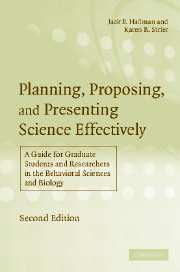 Planning, Proposing, and Presenting Science Effectively
Planning, Proposing, and Presenting Science Effectively 5 - How to write a curriculum vitae
Published online by Cambridge University Press: 01 September 2010
Summary
The writer of his own life has, at least, the first qualification of an historian, the knowledge of the truth.
Samuel Johnson (1709–84)A curriculum vitae, affectionately known as a c.v., is a summary of one's academic career and qualifications, usually prepared by an applicant seeking employment or other support. The commercial world tends to use the French term résumé for the equivalent document. Curriculum vitae means literally the course of life (in Latin), and it intends to be a short summary, although modern c.v.s can sometimes be quite lengthy, depending upon the specific purpose for which they are drawn up. Although most of a c.v. consists of itemized lists, some general exposition may be involved; much of Appendix A on writing clearly therefore applies.
There is no prescribed format for a general c.v., although its contents are reasonably standard. For specific purposes, as in a tenure-review document, a university or other body may require a c.v. in special format. We emphasize the contents that typify a c.v. drawn up by a new doctorate seeking a postdoctoral position or assistant professorship, although we also include mention of sundry items that are often more applicable to someone at a later stage of his or her career. As it may not be obvious why certain items are desirable to include in a c.v., we offer our explanations as to their inclusion. However, we urge you to seek feedback on your c.v. as you prepare it for different purposes and whenever you substantially revise its format or content.
- Type
- Chapter
- Information
- Planning, Proposing, and Presenting Science EffectivelyA Guide for Graduate Students and Researchers in the Behavioral Sciences and Biology, pp. 149 - 164Publisher: Cambridge University PressPrint publication year: 2006
- 1
- Cited by


